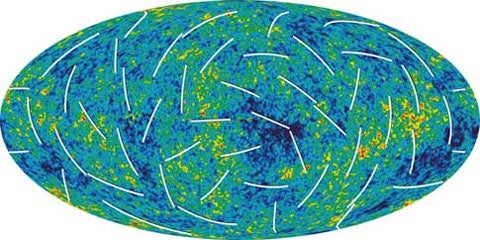The Wilkinson Microwave Anisotropy Probe (WMAP) team announced today its long-awaited release of 3 years’ data. This release confirms findings from the first year’s data — precise temperature measurements of the cosmic microwave background (CMB) — and added another set of discoveries. The new data focus on the CMB’s polarization — a measure of light’s direction orientation.
The WMAP team used a new technique to measure how much of the Big Bang’s afterglow — the CMB — is polarized. The polarization signal is roughly 100 times fainter than the signal the probe measured 3 years ago.
In the first year of data, scientists could not separate the effects of light scattering from the first stars and the effects of inflation. The polarization measurement, however, is sensitive only to the first stars, so scientists can now separate the two.
The first generation of stars filled the universe with a fog that reflected and polarized the early universe’s afterglow light. Light from the very early universe is not polarized, so scientists can use the WMAP polarization measurements to peer through this fog to the universe’s first trillionth of a second.
Scientists can now look at the brightness pattern WMAP detected and determine how much of a brightness change, in the light detected today, is from the first stars or from the cosmos’ first trillionth of a second. For the first time, they can “look at brightness patterns from inflation and know it’s from inflation and not from the first stars,” says WMAP’s Principal Investigator Charles Bennett of Johns Hopkins University.
According to inflation theory, microscopic fluctuations in the early universe were converted into larger fluctuations by inflation. The simplest versions of inflation theory predict larger features will be brighter than smaller features. This is exactly what WMAP found, providing further evidence that inflation occurred in the early universe.
In addition, scientists can rule out more complicated models of inflation with this new data. WMAP member Lyman Page of Princeton University says, “People had been flying blind. This [data] gives them guidance” to narrow inflation models.
From the improved precision, the new WMAP findings also determined the first stars formed 400 million years after the Big Bang, instead of 200 million years, as previously believed.
WMAP’s 3-year data are a factor of 2 more precise than the first year’s data. With the greater precision, scientists also can constrain the universe’s density parameters: 4 percent is ordinary matter, 22 percent is dark matter, and 74 percent is dark energy.










